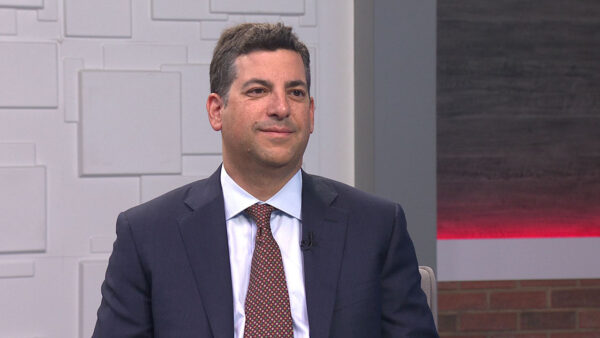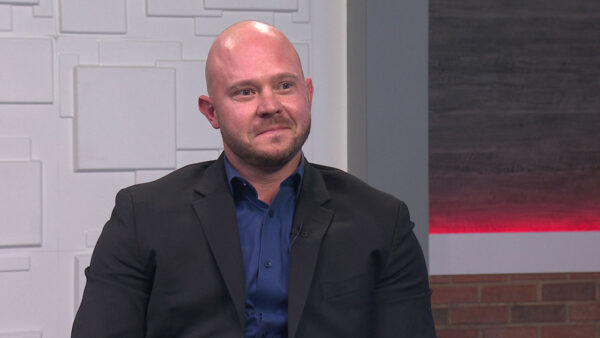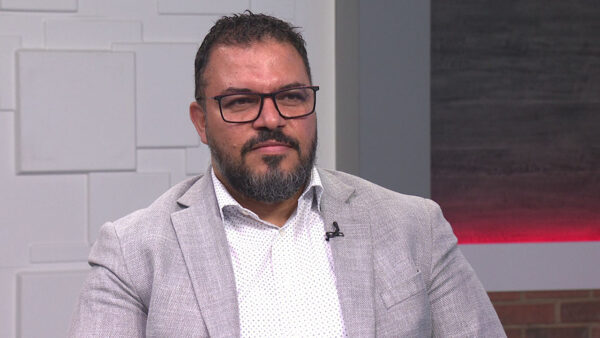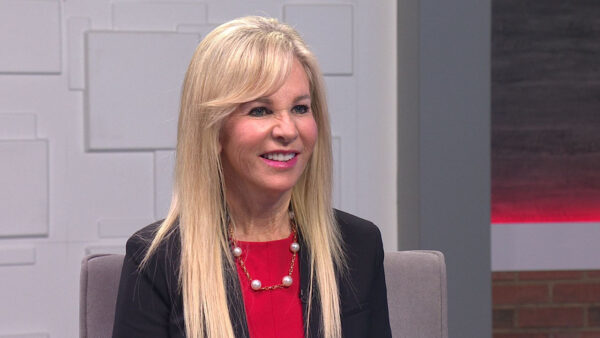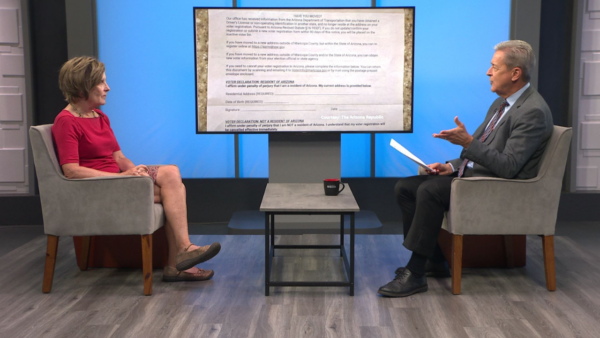The latest real estate figures show the median sales price for an existing home topped a quarter of a million dollars this year in Maricopa County. HORIZON examines the impact Arizona’s housing boom is having on thousands of families who are now unable to afford a home. Stardust Cos. CEO Greg Holmes, housing consultant David Rosen, and Michael Pyatok, Executive Director of the ASU Stardust Center for Affordable Homes and the Family, join Michael Grant to discuss the growing concern over affordable housing.
>> Michael Grant:
Tonight on " Horizon," a booming housing market is driving up the price of homes and pricing thousands of families out of the American dream of home ownership.
>> Russell McElhaney:
Kind of amazing how the housing market is skyrocketing and the prices.
>> Nicole Wilson:
It's hard right now for buyers, especially average income buyers.
>> Michael Grant:
And experts say it will only get worse. That's why a taskforce is looking at solutions. I'll talk to members of that taskforce about what the public and private sector can do to make sure we have sufficient affordable housing.
>> Announcer:
"Horizon" is made possible by the friend of channel 8, members who provide financial support to this Arizona PBS station. Thank you.
>> Michael Grant:
Good evening, I'm Michael Grant. Welcome to "Horizon." The median home sales prices in the Phoenix area have reached a quarter million dollars. That's according to ASU's real estate center. As we continue our four-part series "housing Arizona," we look at the impact of booming housing market has on home affordability. A year ago, the median home sales price for the metro Phoenix area $175,000. Now it's jumped to almost $250,000, a 43% increase. While skyrocketing home prices may be great for sellers, it's a different matter for homebuyers. Escalating home prices makes the American dream almost impossible for tens of thousands of families. Paul Atkinson reports.
>> Reporter:
A for sale sign. They pop up from time to time in this neighborhood northeast of downtown Mesa. The McElhaneys live across the street from the home for sale. Dad, Russell, mom, Emily, daughter, Samantha and son Caleb moved into their home two years ago.
>> Russell McElhaney:
Finding this home was a long process for us. I'm a schoolteacher, and that became a concern when we looked at our financial situation. We had a couple little kids, and we were trying to figure out how we could get a home, and afford to get the home, having the situation we had.
>> Reporter:
The McElhaneys got in just in time. They bought their house for less than $130,000. The home across the street is for sale for twice as much, although it does have a pool and is remodeled throughout.
>> Russell McElhaney:
We were very fortunate to get into a home when we did. Looking at today's market.
>> Emily McElhaney:
We've been watching the market just in our own neighborhood, friends who have sold their homes and friends who are looking to buy homes. If we didn't buy two years ago when we did, we probably wouldn't be able to at this time.
>> Reporter:
That's the position Nicole Wilson finds herself in.
>> Hi. I'm here to see Maria Gonzalez.
>> Reporter:
She is meeting with a loan officer to qualify for a new loan after coming up empty handed the past three months.
>> Nicole Wilson:
I've looked at houses, and they are putting them on the market for a certain amount, but they are selling for $20,000 over what the people are even asking for it.
>> Edna McLaughlin:
It's more difficult now than ever to bid on a property, because we have a lot of investors right now coming into the market and buying houses.
>> Reporter:
Edna McLaughlin is director of education at housing for Mesa.
>> Edna McLaughlin:
We have an influx of families looking for affordable homeowner ships. I'm not talking about families earning low income, I'm talking but two-income families, families earning $40,000 and $50,000 that maybe have large families that just can't get into the market. So there is a huge since of frustration there.
>> Reporter:
Wilson is frustrated but she hasn't lost hope. She wants the benefits home ownership has to offer.
>> Nicole Wilson:
My children are growing up, and I'm just looking for a home that's in a nice neighborhood and a good school district. I've been running for so many years that it's time for me to invest my money into something that I can call my own.
>> Reporter:
Buying a home allows Wilson to build equity that she can tap to send her kids for college or use for other major expenses.
>> Edna McLaughlin:
It's also a lot more stable for families to have their own home, to be in the neighborhood, to be part of the community, to be close to work or at least you know, in the same location, and it strengthens neighborhoods to have homeowners really take care of the homes versus what we are seeing a lot now is investors coming in and renting out or even vacant homes.
>> Reporter:
The McElhaneys wanted to stay in the neighborhood where they rented and their oldest daughter went to school. Some of their friends were forced to live much further away because it's the closest housing they could afford to buy.
>> Emily McElhaney:
It's just not affordable for a lot of young families, and we have friends who are struggling light now trying to find a place to live and so they are moving further south, very far south, in order to find something that they can afford.
>> Reporter:
One reason is that salaries cannot keep up with the huge increase in home prices.
>> Nicole Wilson:
Something I can afford maybe last year is so much more expensive and it's really hard for, you know, an average income or single family home -- single income home to find something that they can afford.
>> Reporter:
It doesn't mean Wilson can't buy a home, it just may not be what she ideally wants. Economist Elliot Pollack.
>> Elliot Pollack:
Prices have increased nearly 25% over the last year, which means, (A), you could be priced out of the market or (B), you're probably buying less of a house than you wanted to or (C) you are putting more money into a house than you want to. One of those three things is going on. Right now, you can still by new housing in Phoenix for $150,000 $120,000. You are not living where you want to be but it's available.
>> Reporter:
But for people like Wilson and the McElhaneys, buying father away would increase the cost of transportation and decrease the amount of time with their children, who don't want to move too far from their school and friends.
>> Emily McElhaney:
It's still hard month to month, but we're making it, and we're glad that we're finally gaining some equity instead of just renting every month.
>> Reporter:
The McElhaneys are glad they got out of the home buying game before prices skyrocketed.
>> Russell McElhaney:
I just wonder what's going to happen with the market the way it is and, you know, you wonder how long this can go on.
>> Michael Grant:
Joining me now is Gregg Holmes, president and CEO of stardust initiatives, a nonprofit working to increase the amount of work force housing. Also here, Michael Pyatok, executive director of ASU's stardust center for affordable homes and the familiarly. Rounding out our panel is David Rosen, an Oakland based housing consultant for the regional taskforce on quality work force housing. Gentlemen, thanks for joining us. I want to start with that where is it going. David, we've seen the future and it's California? Is that what you are telling me? California was where we are, you were saying about four to five years ago?
>> David Rosen:
Four years ago. Median house price in California today is $560,000. That's a $100% increase over the price four years ago, about $275,000 or just below that today.
>> Michael Grant:
What is fueling this enormous boom in prices in your opinion?
>> David Rosen:
Demand. The population growth in the county is huge. Annually Maricopa has experienced something like a 3-1/2% increase in population annually for the last 20 years. The Maricopa association of governments is projecting 35,000 units are going to be needed every year for the next 15 years just to meet the projected growth and that says nothing about families as in your segment who are already priced out of the market.
>> Michael Grant:
Gregg, let's talk about some of the impacts of what's happening here. First, as opposed to affordable housing, we are calling it "workplace housing"?
>> Gregg Holmes:
Work force housing.
>> Michael Grant:
Why?
>> Gregg Holmes:
Well, I think that you are talking about opportunities for home ownership for firefighters, for teachers, for pharmaceutical technicians, bank tellers, and I just think it puts a more appropriate face on really what we're talking about, and in our instance relative to the taskforce, we've framed that in the context of specific income bracket. People making between 20 and 42,000 dollars a year. These are folks that protect our streets and take care of us when we're sick. Unfortunately, we can call them heroes, but we can't call them neighbors, and I think that's unfortunate. So work force housing, if you will, is to us, from the taskforce perspective a more appropriate way to reference -- go ahead.
>> Michael Grant:
I was going to say for lack of a better term there is a PC element to this as well, as well as an attempt to get away, I think, from some derogatory connotations that attaches to affordable housing.
>> Gregg Holmes:
Historically, affordable housing has had a stigma attached to it. People view it as government subsidized slums. The fact of the matter is, the quality work force housing we're talking about is a place that we would all be happy to live in, and we should be able to. You know, we should be able to live and work in the same community. Unfortunately, the trend is moving in the other direction.
>> Michael Grant:
Michael, Gregg mentioned some stats. When we move from $175 median, to $250, median, what does that mean in terms of affordable housing? What does that mean in terms of who can qualify, who can't and at what level and those kinds of things?
>> Michael Pyatok:
You are talking to an architect here and not a policy wonk. But from the standpoint of the housing stock itself, affordable housing or work force housing is as good, if not better than many market rate versions of housing. And as the price goes up of the market rate, you've gotten larger and larger slice of the population that can't afford the market driven housing. Yet, they have the same expectations for quality housing. So whose who are produce affordable housing are basically striving and oftentimes exceed the quality of the market rate housing because they are basically serving people who deserve the best, the hardworking Americans.
>> David Rosen: There have been numerous studies that have shown maybe counter to perception that when work force housing of the quality Michael is talking about goes in, the values of the surrounding real estate go up not down.
>> Michael Pyatok:
What's also happened in the last -- well, we've learned a lot in the last 50 years about how to design quality neighborhoods and quality affordable work force housing. So far cry from what we were doing in 1950, with the public housing. The housing we're talking about is really produced by the private sector. It happens to be primarily the nonprofit portion of the private sector. The quality of the housing is such that when you look at the design awards programs that are occurring around the country, very often, it's the work force affordable work force housing produced by the nonprofits walking away with the awards. And the private developers producing the market rate are stunned and they are taking a second look at the ideas that are coming out of the affordable housing industry to move into the market rate housing.
>> Michael Grant:
Gregg, go back to that segment that you were talking about, the median income, $20-$42,000? Was that the range you gave me? Quantify that in terms of what that family can afford.
>> Gregg Holmes:
Well, at the high end of that range, $42,000, let's call it $38-$42,000. We feel that a house priced at $150,000 is something that's affordable. Now, you look at that in relation to the numbers that you just talked about and there is a huge gap. But yet, wages have simply not kept pace, as you saw in the opening piece. And that makes it much more difficult for families to live and work in the same community. The impact of which is excessive commutes, poor productivity in the workplace, added mobility which many times negatively affects the students' performance in the classroom, and to a certain extent --
>> David Rosen:
they don't have a stable home.
>> Gregg Holmes:
That's right. The lack of work force housing infrastructure prevents us from having high wage jobs.
>> Michael Grant:
On the other hand, though, I would never hold up the Los Angeles metro area as --
>> David Rosen:
my home town --
>> Michael Grant:
As an example, but say what you want about California, I mean, they've been coping with this same phenomena for a long time. You've got 90-minute communities and people use books on tapes and --
>> David Rosen:
-you have 150,000 people in Los Angeles living in illegal garage units. I mean, a big face of the housing crisis is invisible. It's families straining a family budget, choosing between keeping the lights on, paying the rent or getting their sick child to a doctor. It's families doubling and tripling up in a one or two bedroom unit. It's families living in garages, literally with -- I've seen these conditions with extension cords running to the house to provide electric power. The damage to the local economy, to families, to the fabric of a community builds up.
>> Michael Pyatok:
The absence of the affordable work force housing really makes our neighborhoods more unstable, because you've got a high degree of transience see. People are shifting around looking for a better rent or sales price. So you don't get those long, stable tendencies where people are there for five, ten, 15, 20 years and the kids go through the schools having all the same friends and they become -- they merge with the local institutions whether it be the YMCA or the PTA. Those institutions get weakened by this constant transience see that the work force is put into because they can't find affordable housing. So neighborhoods that resist having affordable housing are only contributing to their own long-term instability.
>> Michael Grant:
David, let's try to kick around some possible solutions here. First off, Phoenix area just generally in relation to this subject. Are we behind the curve considerably? At the curve? Ahead of the curve? What?
>> David Rosen:
I'd say behind the curve. The county is producing on average over the last 15 years about 1200 units of affordable work force housing. It may sound like a big number, but the unmet demand currently projected through the year 2020 that we see in the valley approaches 150,000 families. That's nearly half a million people, 26% of the work force in your community. So to tackle that huge a number requires a kind of collective community will to address issues of financial resources, land use policy, counteracting the kinds of negative stereotypes that Gregg alluded to. People's fears or concerns about affordable housing bringing down the neighborhood when quite the opposite is that this stabilizes and builds local economies. So I think the solutions involve the creation of new revenue sources dedicated to the production of housing so families can be stable and afford where they live. A reexamination of land use policies throughout the county, looking at how we build out our housing relative to our job centers, what kind of densities make sense for three to five units to the acre, detached acre or housing that's closer together, a little cheaper to build, but where we might get the kinds of families in your segment to afford to actually buy the unit.
>> Michael Grant:
Michael, do you start turning to builders -- I think some element of this currently goes on, here, certainly more so than other areas, do you start turning to builders and affirmatively saying, okay, we'll, you know, for example, give you zoning on this particular piece of property that will accommodate the half million dollar homes, but in exchange, you've got to give us 30, $150,000.
>> Michael Pyatok:
That notion of including within any new market rate development some affordable work force units is universal. It's all over the country. Many communities are employing that strategy and developers and the builders in those regions are concerned about it or suspicious but they fall into it but before you know it they're loving it.
>> Michael Grant:
Why?
>> Michael Pyatok:
Well, to give you a case in point -- well, I won't mention the cities or the developers, but they often see that when they come into an area, they want to meet the full range of the market. They can't always satisfy the high end of the market, because there is only so many folks in that slice of the market, but if they meet several levels simultaneously, they sell out all of their units. In fact, they will often start with the affordable units first because that gets the area going quickly. Those units sell like hot cakes. There's a huge demand for them. The neighborhood gets started up quickly and then they can gradually build up to the higher-end units. Many of the nationally based developers, lovingly produce the affordable piece. It's good for marketing.
>> Gregg Holmes:
It's something that needs to be economically beneficial and viable, which is why it's so necessary for a builder to have the opportunity to experience some change in the land use policy, and policies affecting them, such as the density requirements or design requirements and so there's a collaboration that really needs to occur.
>> Michael Grant:
Gregg, there is a central planning element here that I think a lot of people are nervous about, and perhaps understand plea, so. I mean, government can and sometimes in fact frequently does make mistakes. I mean, how do you get around that?
>> Gregg Holmes:
Well, as a practical matter, the state calls for a general plan to be put together on an every ten years and approved by the voters, the citizens. That in most of the communities requires a housing element, so you can walk people through, if you will, what your plan is for your growth and how you plan to grow logically. I think what we're suggesting is a function of what the taskforce has looked at. Is there simply needs to be some review of the land based -- the land use practices right now and policies that are driving things like density. Such that when you marry those two together, they create more motivation on the for-profit builders to create the production of work force housing to meet the demand. Right now, there is not the kind of incentive necessary to drive the production.
>> Michael Grant:
So we've got sticks, we haven't got any carrots? Is that what you are saying?
>> Michael Pyatok:
In a sense. It's often felt by folks that government makes mistakes and makes big mistakes. The private sector makes mistakes, big mistakes, too. If you look at silicon valley or
>> Michael Grant:
Charles Keating.
>> Michael Grant:
He's turning out to be a visionary.
>> David Rosen:
I haven't kept up with his career.
>> Michael Grant:
He was 15, 20 years ahead of the market, but the west side is going nuts.
>> Michael Pyatok:
To complete my thought, the price of housing to such a point where the primary employers in the region couldn't remain competitive in the global market. They could not pay the wages and still remain competitive. The wages necessary to feed a runaway housing market. So that's the market gone amuck on its own basis. So, some assistance by thoughtful government participation with the private sector, allows for a solution that satisfies everyone's needs.
>> David Rosen:
I never met a developer who thought the development approval process went fast enough, and I never met a local planning official who thought developers were responsive enough. And so, I think what we're faced with is a local government by its very nature zones its land. That's really what cities and counties do. They are charged to do it. In Arizona, voters must approve those plans, actually. I think what we're talking about here is crafting a better plan, which takes the best from public initiative and the best from private sector practice. A lot of great minds and practitioners on this taskforce, and one of the great advantages here in the valley is the taskforce has brought together a talent of 50-odd stakeholders from all walks of life with a stake in this problem.
>> Michael Grant:
I just tossed out one model. What are some of the other things that seem to work. We've been talking about okay, Mr. Builder, you want to do 200 of those, give me 50 of these. But what are other things that have worked in other markets?
>> David Rosen:
Well, Arizona has available to it a federal bond and tax credit program which is expressly targeted at building and acquiring and rehabilitating affordable work force renter housing, and that program is actually underused in the state. You have $409 million of authority for the program, but only 10% of that is allocated to better housing. And it comes with these free federal tax credits that pay for about 25% of the cost of housing. So if the State --
>> Michael Grant:
Rents fuel the bonds and ultimately repay the bonds? Have I got that --
>> David Rosen:
-the rents repay the bonds. These are private bonds, not government bonds. They are tied to repayment by the rental stream from the rental apartment community.
>> Michael Grant:
I'm getting some tax breaks as a lender?
>> David Rosen:
As a lender you are getting a loan repaid. Wells Fargo, Bank One, premier corporate names in Arizona are investing in these credits and very happy to do so, and profitably. They are making rents affordable to the families we're talking about.
>> Michael Grant:
Gregg, you mentioned, and Michael did as well, employer participation. I think Minnesota, I've got a note here, Mayo clinic, chipped in a lot of money on affordable housing. Is that another thing that --
>> Gregg Holmes:
-sure, and one of the things that David is familiar with is the housing trust fund started in San Jose. You know, that was driven by the Silicon Valley manufacturers group, which is a composition of employers, Hewlett Packard, among others, Intel, for example. They were the first million dollars in, because they had people commuting excessively two hours to work one way. And just said, enough is enough. And they created about a $21 million fund. I think leveraged it 7 or 9 to 1 and have created pretty significant production of housing in a very quality way to address that problem.
>> Michael Pyatok:
I think another way of looking at these various ways by which the government gets involved in providing assistance whether it's through tax credits or otherwise, in conjunction with the private sector, these government programs are in the sense or they appear to be assisting the worker. They are actually indirect subsidies to the employers. Helping those employers compete in the marketplace, by not having to give pay -- pay excessive wages to feed the local runaway housing market. So it makes them more competitive by having this government assistance in the housing market. It allows those industries to stay in the region in the first place and allows them to hold onto that work force that they helped train so that they don't have to be shifting around the country looking for places where the housing is cheaper and therefore the wages -- those government programs are indirect subsidies to the business sector.
>> Michael Grant:
Gentlemen, we have exhausted the time. Michael Pyatok, thank you very much for your participation. David Rosen, good to see you, best of luck in California. Gregg Holmes, always a pleasure.
>> Gregg Holmes:
Thank Michael.
>> Michael Grant:
If you would like more information on the issue of affordable housing, you can visit our web site. You will find that at www.azpbs.org, just click on "Horizon" and you can look for the web links next to tonight's topic.
>> Reporter:
Arizona's housing market drives our economy in many ways from new home construction to financial institutions, and a lot in between. We profile an Arizona-based company that both benefits from and contributes to Arizona's housing industry, and we look at the economic impact of the housing market. We continue our housing series Wednesday on "Horizon."
>> Michael Grant:
Thursday we continue the special series by looking at what happens when the housing market slows down.
>>> Tonight, stay tuned for a KAET special "From Mars to China" thanks for joining us this evening. I'm Michael Grant. Good night.
Gregg Holmes:president and CEO, Stardust Initiatives;










